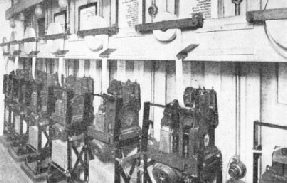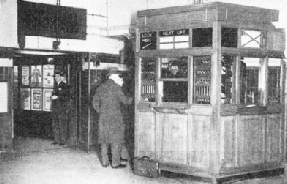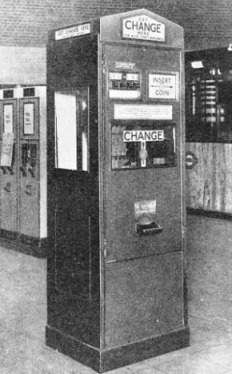

Ticket and Change Machines
Mechanical Aids that Speed-

BUNCH HOPPER TICKET MACHINES, at Wood Green Station, on the Piccadilly Line of the London Underground Railway system.
AS we have seen in an earlier chapter, the first railway tickets were generally made of paper. They were partly printed and partly handwritten by the booking clerk, who retained the left-
The inconveniences of the primitive paper ticket and of the clerical work involved by its use soon became evident, and the first material improvement was due to Thomas Edmondson, then a chief booking clerk on the Manchester and Leeds, whose machine was first employed on the Liverpool and Manchester, and shortly afterwards, in an improved form, introduced on the Manchester and Leeds, and London and Blackwall, where it was adopted in or about 1840.
To all intents and purposes, Edmondson invented the system of to-
Serial numbering represented a much more important innovation than may appear on the surface. It not only lessened clerical labour (and thus reduced delay at the booking office), but it also provided the clerk with a quick and accurate method of checking his cash receipts. By noting the top number in each rack on going and coming off duty, it is now a simple matter for him to ascertain whether the money taken tallies with the number and nature of the tickets sold.
Substantially, Edmondson’s ticket machine survives as the standard to this day. It is, however, necessary at times to issue a card or paper ticket on which the name of the arrival station is written, if bookings to the particular destination from the point of departure are unusual.
On issue, tickets are stamped with the date, and since this means two printings, at different times and places, many machines have been designed for printing tickets at the moment of issue, thus effecting a considerable saving in time.

ANOTHER VIEW of a battery of Bunch Hopper ticket machines, showing the mechanism.
These range from appliances that will deliver a ticket for only a single prescribed station to installations that virtually do the work of a booking office. On the Continent this latter type has been developed to the extent of printing and issuing tickets in all three classes for a considerable number of stations. In addition it issues such special varieties as tickets for soldiers at reduced rates, and for dogs accompanied by passengers.
The machines which combine printing and issuing are of two main types -
On no system in the world has machinery been used to such a remarkable extent as on the London Underground railways, and a description of their methods will serve to describe the mechanical system in general.
On the Underground the situation had become particularly complicated prior to the use of mechanical methods, because of the immense variety it was necessary to keep in stock. Prior to the beginning of 1911 it was the practice to have, save in certain instances, a separate form of ticket from each station to every other station. That was, and is, the system in use on the main lines, but on short-

AT SOME STATIONS the booking clerk is not only in charge of a mechanized booking office, but he also controls the lifts.
The first step was the adoption of the so-
The “scheme ticket” was, however, only one step. Mechanization in an elementary form had begun as early as 1904, when the pull-
Before leaving these earlier devices, reference should be made to the passimeter booking office. The passimeter is a form of turnstile, and when it is attached to the electric slot machine the installation carries out the fourfold duties of issuing, dating, and cancelling the ticket, and of electrically releasing the turnstile itself. Although its use thus materially lightens the work of the booking office, it does not eliminate the human element in ticket issuing, since, as mentioned above, so large a proportion of passengers require change. The turnstile, it may be added, automatically re-

THE AUTO-
At the same time that the passimeter was first under consideration, experiments were being made with automatic machines for use inside the booking offices. These were of two types, the “Automaticket” and the “Rolltic”.
The first, which is driven by an electric motor of about one-
All the devices hitherto described are merely appliances for issuing ready-
Operation, which is electrical, is by pressure on one or more buttons, according to the type of ticket required; the machine prints, cuts and delivers the ticket, and can issue four a second. All types of tickets -
Change-

A CHANGE-
Printing is here effected on a roll long enough to provide two thousand tickets, thus avoiding the necessity of constantly refilling at busy stations, which is one of the drawbacks on the coin-
Recent tests have shown that the passenger can aid the machine in the matter of speeding up booking. This is particularly noticeable when it comes to picking up change, and the booking offices at busy stations are now equipped with a special change plate designed with an upward curved rim, which enables passengers to scoop up their money instead of sliding it towards them.
£200,000 a Year on Tickets
At certain stations, such as Baker Street, the ticket clerk not only has charge of a mechanized booking office, but also controls the opening and closing of the lift gates.
There are also some stations normally handling a limited traffic, such as the Aldwych terminus of the Piccadilly Tube (on which section two-
At these stations the booking office is installed in the lift itself, and the tickets are both of standard card pattern and printed on continuous rolls of thinner material.
Mention has been made of the fact that the most expensive printing and issuing machines soon save their cost. One reason for the mechanization of the booking office is that on railway systems where the average passenger is carried for only a short distance, the expenditure of the ticket department is relatively high in comparison with operating costs as a whole. On the London Underground it represents about £200,000 a year, or approximately 6 per cent of the total operating expenditure.
Machinery effects an economy, and at the same time provides the public with certain added facilities, as at Trafalgar Square, where the equipment comprises a booking office, a battery of ticket-
With an installation of this type, congestion at the booking office windows is materially lessened, especially at times when there is a sudden and unexpected influx of passengers, as during a thunderstorm.

THIS TICKET MACHINE issues tickets for journeys that cost from one penny to sixpence. The plates below the fares indicator show the names of stations. Another type of ticket machine also has an appliance for the issue of weekly season tickets.
You can read more on
on this website.
You can read more on
Wonders of World Engineering